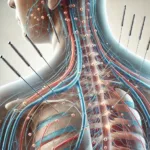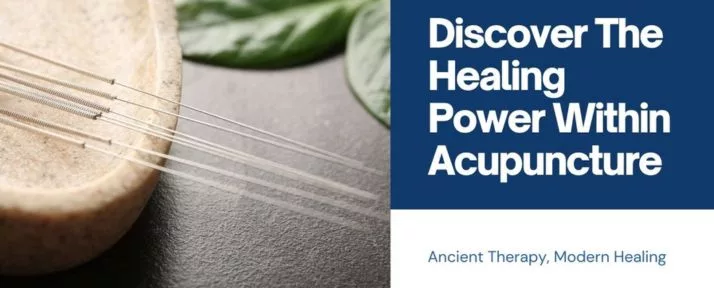Acupuncture is more than just an alternative treatment; it’s a chapter from the annals of ancient medicine that continues to unfold today. Chronic pain affects millions worldwide, leading many to seek out alternative treatments like acupuncture. This article will show you how acupuncture bridges past wisdom and modern healing, offering relief to those grappling with chronic pain.
The Origins of Acupuncture
 Acupuncture is an art form born in the East, believed to have originated over 2,000 years ago. Initially rooted in Traditional Chinese Medicine (TCM), it involves using fine needles to adjust the body’s life energy, or ‘qi,’ flowing through meridians or pathways. This ancient practice has now found its way into our 21st-century medical toolkit, particularly for managing chronic pain.
Acupuncture is an art form born in the East, believed to have originated over 2,000 years ago. Initially rooted in Traditional Chinese Medicine (TCM), it involves using fine needles to adjust the body’s life energy, or ‘qi,’ flowing through meridians or pathways. This ancient practice has now found its way into our 21st-century medical toolkit, particularly for managing chronic pain.
Modern Acceptance of Acupuncture
In recent years, numerous studies and clinical experiences have led to acupuncture gaining respect and acceptance as a potent pain management technique. Physicians now often recommend it as part of a multidisciplinary approach to pain relief. Understanding the rich heritage behind acupuncture enhances its capacity to help those in pain.
How Acupuncture Works to Relieve Pain
The Biological Response
You might wonder how thin needles can significantly reduce pain. It’s not magic; it’s science. When an acupuncturist inserts these needles into specific points on the body, it triggers a fascinating chain reaction, targeting your body’s natural pain relief mechanisms, particularly endorphins.
During acupuncture, these needle points stimulate nerves, muscles, and connective tissue, boosting circulation and activating your body’s natural painkillers. This is akin to flipping a switch to ignite your internal pain relief system, flooding your body with endorphins that numb pain and foster a sense of well-being.
circulation and activating your body’s natural painkillers. This is akin to flipping a switch to ignite your internal pain relief system, flooding your body with endorphins that numb pain and foster a sense of well-being.
Nervous System Regulation
Acupuncture also influences the nervous system, helping to regulate pain perception. It turns down the volume on pain signals sent to the brain, which can be especially beneficial for those living with chronic pain. Each session is a step toward retraining your body’s response to pain, potentially offering long-term relief.
Scientific Support for Acupuncture
The effectiveness of acupuncture in managing chronic pain is supported by robust scientific studies.
- Study 1: A 2012 meta-analysis published in the Archives of Internal Medicine found that acupuncture is effective for the treatment of chronic pain, including back and neck pain, osteoarthritis, and chronic headache. The analysis, which included nearly 18,000 patients, showed that acupuncture provided significant pain relief compared to no acupuncture or sham acupuncture.
- Study 2: A 2018 study published in the Journal of Pain found that acupuncture provided significant pain relief and improved function for patients with chronic pain conditions. The researchers noted that acupuncture could be a valuable component of a multidisciplinary approach to pain management.
Acupuncture’s Impact on Chronic Conditions
Many people dealing with chronic pain are turning to acupuncture, enticed by its potential to offer relief without medications. Scientific investigations support anecdotal success stories, providing compelling evidence that acupuncture can significantly reduce discomfort in various conditions.
Conditions Treated
Among the conditions most frequently treated with acupuncture are:
- Back Pain
- Arthritis
- Migraines
- Fibromyalgia
- Carpal Tunnel Syndrome
Studies show measurable improvements in pain levels and overall function after acupuncture treatment. The effects can be categorized as either short-term or long-term. In the short term, patients often experience immediate relief following a session, which can last for several days. Long-term benefits may include a gradual reduction in pain intensity and frequency, improved sleep, and a greater sense of well-being.
Integrative Approach to Pain Management
 Acupuncture isn’t just an ancient art; it’s a viable, scientifically supported method for managing chronic pain. For those considering acupuncture, it’s worth discussing with a healthcare provider to see if it could be a suitable part of your pain management strategy.
Acupuncture isn’t just an ancient art; it’s a viable, scientifically supported method for managing chronic pain. For those considering acupuncture, it’s worth discussing with a healthcare provider to see if it could be a suitable part of your pain management strategy.
Finding a Qualified Acupuncturist
It’s essential to look for a qualified acupuncturist — credentials and experience count. Ensure they have board certification and training in line with state regulations, as you’re entrusting them with your well-being.
Don’t like needles? Take a look at Natural Synergy – a revolutionary, non-invasive alternative to electro-acupuncture that you can use in the comfort of your home.
Combining Acupuncture with Other Treatments
Consider combining acupuncture with other treatments you may be undergoing. It often complements traditional therapies, working in tandem to provide the best possible outcomes. Acupuncture could be the missing piece in your comprehensive pain management plan.
Final Thoughts
Acupuncture offers a bridge between ancient wisdom and modern healing, providing a drug-free option for those seeking relief from chronic pain. With its solid scientific backing and multifaceted benefits, acupuncture deserves a place in your pain management strategy.
Don’t forget there is a needless way to get the same relief. Take a look at Natural Synergy today!
JOIN OUR COMMUNITY

